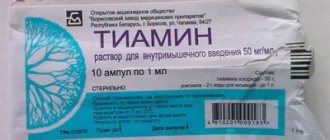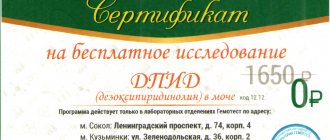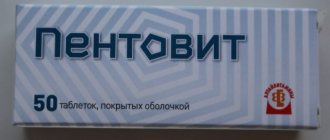Compound
1 tablet contains 100 mg of benfotiamine and 100 mg of pyridoxine hydrochloride - active ingredients.
Minor ingredients: povidone (K 29/32), microcrystalline cellulose (101) and (102), corn starch, calcium stearate, anhydrous colloidal silica, talc.
Shell: Opadry II 85 F 18422
1 ampoule contains 50 mg of thiamine hydrochloride, 50 mg of cyanocobalamin and 50 mg of pyridoxine hydrochloride - active ingredients.
Minor ingredients: sodium polyphosphate, lidocaine hydrochloride, benzyl alcohol, potassium hexacyanoferrate III, sodium hydroxide, intravenous water.
Pharmacodynamics and pharmacokinetics
The drug Vitaxon belongs to the neurotropic B vitamins , which have positive efficacy in relation to degenerative and/or inflammatory painful conditions of the musculoskeletal and nervous systems. This group of drugs is indicated for the prevention of deficiency conditions .
In increased doses, it improves blood circulation , exhibits an analgesic effect, and helps normalize hematopoietic and the activity of the nervous system .
One of the active ingredients , vitamin B1 , is phosphorylated in the body to form biologically active substances: thiamine triphosphate (TTP) and thiamine diphosphate ( cocarboxylase ). As a coenzyme , cocarboxylase is involved in the metabolic processes of nerve fibers and carbohydrate metabolism , and at synapses it influences the conduction of nerve impulses.
With a lack of vitamin B1, metabolites accumulate in tissues, primarily pyruvic and lactic acids , which can lead to various disorders and pathological conditions of the functionality of the nervous system.
The phosphorylated form of vitamin B6 (pyridoxal 5'-phosphate, PALP) is a coenzyme of a group of enzymes that jointly participate in general amino acid metabolism (non-oxidative). Through decarboxylation, they take part in the formation of physiologically active amines ( histamine , adrenaline , serotonin , tyramine , dopamine , etc.), through transamination, they participate in catabolic and anabolic metabolic processes (for example, glutamate-oxalacetate transaminase) and various processes of replication and cleavage of amino acids .
Pyridoxine affects 4 different stages of the metabolic transformation of tryptophan ; during the synthesis of hemoglobin it acts as a catalyst for the production of α-amino-β-ketoadinic .
Vitamin B12 is indispensable in the process of cell metabolism , affects hematopoietic function (anti-anemic external factor), participates in the formation of methionine , choline , nucleic acids , creatinine , and exhibits analgesic activity.
When taken orally, with the assistance of intestinal phosphatases, benfotiamine is dephosphorylated to fat-soluble S-benzoyl thiamine (SBT), which is highly permeable and absorbed without significant conversion of thiamine .
Absorption of pyridoxine , as well as its derivatives, mostly occurs quickly in the upper gastrointestinal tract using passive diffusion, with release within 2-5 hours. Pyridoxal and pyridoxal-5-phosphate bind to albumin . Pyridoxal is the transportable form. To penetrate cell membranes, albumin- pyridoxal 5-phosphate is hydrolyzed to pyridoxal by alkaline phosphatase .
Benfotiamine , unlike thiamine , does not have saturation kinetics. While the absorption of water-soluble vitamin B1 remains low, the bioavailability of benfotiamine is almost 100%. Benfotiamine also remains in tissues longer.
thiamine is distributed in the body. Approximately 1 mg of thiamine is metabolized daily, with metabolites excreted through the kidneys. The dephosphorylation process is observed in the kidneys, with T1/2 of about 21 minutes. Due to low fat solubility, accumulation of thiamine in the body is not observed.
The transformation and excretion of injectable pyridoxine occurs according to the same pattern as when taking it orally.
When administered parenterally, cyanocobalamin forms protein transport complexes that are quite quickly absorbed by the bone marrow , liver and other organs. Vitamin B12 enters the bile and is involved in enterohepatic circulation, and also crosses the placenta .
Pharmacological properties
Pharmacodynamics.
neurotropic B vitamins have an effect on inflammatory and degenerative diseases of the nervous tissue and musculoskeletal system. they are used to eliminate deficiency conditions, and in high doses they exhibit analgesic properties, help improve blood circulation, normalize the functioning of the nervous system and the process of hematopoiesis. Pharmacokinetics. Vitamin B6 and its derivatives are mostly rapidly absorbed in the upper digestive tract by passive diffusion and are excreted within 2–5 hours.
Indications for use
Vitaxon tablets
Symptomatic treatment of various painful conditions of the nervous system:
- alcoholic and diabetic polyneuropathy ;
- neurological diseases of a systemic nature, due to deficiency of vitamins B1, B6 .
Vitaxon injections
Pathological conditions of the neurological sphere of various origins:
- neuralgia;
- shingles;
- myalgia;
- alcoholic and diabetic polyneuropathy ;
- radicular syndrome;
- neuritis;
- facial paralysis;
- retrobulbar neuritis.
Vitaxon 2 ml No. 5 solution d/in.amp.
Instructions for medical use of the drug VITAXONE Trade name Vitaxon International nonproprietary name No Dosage form Solution for injection Composition 1 ml of solution contains active substances: thiamine hydrochloride in terms of 100% anhydrous substance 50 mg, pyridoxine hydrochloride in terms of 100% dry substance 50 mg , cyanocobalamin in terms of 100% dry matter 0.5 mg; excipients: lidocaine hydrochloride, benzyl alcohol, sodium polyphosphate, potassium hexacyanoferrate III, 1 M sodium hydroxide solution, water for injection. Description Transparent red liquid with a specific odor. Pharmacotherapeutic group Vitamins. Vitamin B1 and its combination with vitamins B6 and B12. ATC code A11 DB Pharmacological properties Pharmacokinetics After parenteral administration, thiamine is distributed in the body. Approximately 1 mg of thiamine is metabolized daily. Metabolites are excreted in the urine. Dephosphorylation occurs in the kidneys. The biological half-life of thiamine is 0.35 hours. The accumulation of thiamine in the body does not occur due to weak dissolution in fats. After intramuscular injection, thiamine hydrochloride is rapidly absorbed from the injection site and enters the blood (484 ng/ml after 15 minutes). Due to the lack of significant reserves of the vitamin in the body, it must be supplied to the body daily. Thiamine penetrates the blood-brain and placental barriers and is found in breast milk. The main metabolites are: thiaminecarboxylic acid, pyramine and some unknown metabolites. Of all the vitamins, thiamine is stored in the body in the smallest quantities. Thiamine is excreted in the urine in the alpha phase after 15 minutes, in the beta phase after 1 hour, and in the terminal phase within 2 days. Vitamin B6 is phosphorylated and oxidized to pyridoxal-5-phosphate. About 80% of the vitamin binds to blood plasma proteins. Pyridoxine is distributed throughout the body, passes through the placenta and is found in breast milk, deposited in the liver and oxidized to 4-pyridoxine acid, which is excreted in the urine in an amount of 0.05-0.1 µmol/kg body weight per day, after a maximum of 2 -5 hours after absorption. The human body contains 40-150 mg of vitamin B6 and its daily renal excretion rate is about 1.7-2.6 mg, with a replacement rate of 2.2-2.4%. Vitamin B12 after parenteral administration forms transport protein complexes that are quickly absorbed by the liver, bone marrow and other organs. Vitamin B12 enters the bile and takes part in the enterohepatic circulation. Vitamin B12 crosses the placenta. Cyanocobalamin is mainly excreted in the bile, in an amount of 0.5-5 mcg per day, with about 70% being reabsorbed and entering the enterohepatic circulation. When given in high doses (about 0.1-1 mg), significant amounts of cyanocobalamin are excreted by the kidneys (about 50-90% within 48 hours in healthy subjects). Cyanocobalamin has a relatively long half-life (T1/2) of 123 hours. Pharmacodynamics Neurotropic B vitamins have a positive effect in inflammatory and/or degenerative diseases of the nerves and musculoskeletal system. They are used to eliminate deficiency conditions, and in high doses they have an analgesic effect, improve blood circulation, normalize the functioning of the nervous system and the process of hematopoiesis. Vitamin B1 is an important active substance. In the body, it is phosphorylated to form biologically active thiamine diphosphate (cocarboxylase) and thiamine triphosphate (TTP). Thiamine diphosphate, as a coenzyme, takes part in important processes of carbohydrate metabolism and in the metabolic processes of nervous tissue, and affects the conduction of nerve impulses in synapses. With a lack of vitamin B1, metabolites accumulate in tissues, primarily lactic and pyruvic acids, which leads to various pathological conditions and disorders of the nervous system. Vitamin B6 in its phosphorylated form (pyridoxal-5-phosphate, PALP) is a coenzyme of a number of enzymes that interact in the general non-oxidative metabolism of amino acids. Through decarboxylation, they participate in the formation of physiologically active amines (for example, adrenaline, histamine, serotonin, dopamine, tyramine), through transamination - in anabolic and catabolic metabolic processes (for example, glutamate-oxaloacetate transaminase, glutamate-pyruvate transaminase, gamma-aminobutyric acid, alpha-ketoglutarate transaminase), and also in various processes of breakdown and synthesis of amino acids. Vitamin B6 acts at 4 different stages of tryptophan metabolism. During the synthesis of hemoglobin, vitamin B6 catalyzes the formation of α-amino-β-ketoadinic acid. Vitamin B12 is essential for cellular metabolic processes. It affects the function of hematopoiesis (external antianemic factor), takes part in the formation of choline, methionine, creatinine, nucleic acids, and has an analgesic effect. Indications for use As part of complex therapy - neuritis, neuralgia, polyneuropathy (diabetic, alcoholic) - myalgia - radicular syndrome - herpes zoster - retrobulbar neuritis, facial nerve paralysis. Method of administration and dosage The drug is injected slowly deep into the muscle. In severe cases of the disease and acute pain, to quickly increase the level of vitamins in the blood, 2 ml of solution is prescribed intramuscularly once a day. After the exacerbation subsides and in mild forms of the disease, 2 ml is prescribed 2-3 times a week for 2-3 weeks. Maximum single dose: 2.0 ml. Maximum daily dose: 2.0 ml. Frequency of administration: once a day. Course of treatment for at least 1 month Side effects Rarely: - nausea, vomiting - weakness, anxiety - respiratory dysthesis syndromes - paresthesia - drowsiness - skin rash and/or itching - difficulty breathing - Quincke's edema - anaphylactic shock - circulatory collapse Very rare: - increased sweating – acne – urticaria Contraindications – increased individual sensitivity to the components of the drug – decompensated heart failure – severe cardiac conduction disorders – psoriasis – pregnancy and lactation – childhood and adolescence under 18 years of age Drug interactions Vitamin B1 Thiamine is completely destroyed in solutions containing sulfites. Other vitamins are inactivated in the presence of vitamin B1 breakdown products. Thiamine is incompatible with oxidizing substances, mercuric chloride, iodide, carbonate, acetate, tannic acid, ferric ammonium citrate, as well as phenobarbital, riboflavin, benzylpenicillin, dextrose and metabisulfite. Copper accelerates the breakdown of thiamine; in addition, thiamine loses its effect with increasing pH values (more than pH 3). Vitamin B6 Levodopa reduces the effect of therapeutic doses of vitamin B6. Vitamin B6 may also interact with cycloserine, D-penicillamine, epinephrine, norepinephrine, and sulfonamides, which reduces the effect of pyridoxine. Vitamin B12 Cyanocobalamin may increase allergic reactions caused by thiamine. Special instructions With very rapid administration, systemic reactions are possible (dizziness, nausea, arrhythmia, bradycardia, increased sweating, convulsions), which quickly disappear. Peculiarities of the drug's influence on the ability to drive vehicles and potentially dangerous mechanisms. It does not affect the reaction rate when driving vehicles or operating other mechanisms. Patients who experience dizziness after administration of the drug should refrain from driving vehicles or operating other machinery. Overdose Symptoms: dizziness, arrhythmia, convulsions. Treatment: symptomatic. Release form and packaging 2 ml of the drug are placed in brown glass ampoules with a break ring. 5 ampoules are placed in a blister pack made of polyvinyl chloride film. 1 or 2 blister packs of ampoules along with instructions for medical use in the state and Russian languages are placed in a cardboard pack. Storage conditions Store in a place protected from light at a temperature not exceeding 15 ºС. Keep out of the reach of children! Shelf life: 2 years Do not use after expiration date. Conditions for dispensing from pharmacies By prescription Manufacturer OJSC “Farmak” Ukraine, 04080, Kiev, st. Frunze, 63. Owner of the registration certificate Farmak OJSC, Ukraine Address of the organization that accepts claims from consumers on the quality of products (products) in the territory of the Republic of Kazakhstan Republic of Kazakhstan, 050034 Almaty, st. Tole-bi, 291-291a L office 74 Tel/fax, email address
Side effects
For tablets
In isolated cases the following was observed:
- skin rash;
- dyspeptic symptoms;
- itching of the skin;
- state of shock.
For injection solution
With rapid administration, systemic, rapidly passing phenomena were observed:
- dizziness;
- arrhythmia;
- nausea;
- bradycardia;
- convulsions;
- increased sweating .
Allergic manifestations:
- labored breathing;
- skin rash;
- itching of the skin;
- anaphylactic shock;
- angioedema.
In isolated cases:
- acne;
- increased sweating ;
- hives.
Side effects
From the digestive tract: nausea, vomiting, diarrhea, abdominal pain, increased acidity of gastric juice.
From the cardiovascular system: tachycardia.
From the immune system: hypersensitivity reactions, including anaphylactic shock; anaphylaxis, urticaria.
Skin: skin rashes, itching.
In very rare cases: shock.
Long-term use (more than 6-12 months) at a dose above 50 mg of vitamin B6 daily can lead to peripheral sensory neuropathy, nervous agitation, dizziness, and headache.
Instructions for Vitaxon (Method and dosage)
Vitaxon tablets, instructions for use
The tablets are indicated to be taken orally with water.
The recommended daily dosage is 1 tablet in three divided doses.
For acute pain and in severe cases, in order to quickly increase the plasma level of the drug, an injection solution is used. Continuation of therapy, as a rule, requires taking 1 tablet daily for 30 days.
Vitaxon injections, instructions for use
Injections are carried out deep into the muscle, slowly.
For acute pain and in severe cases, in order to quickly increase the plasma level of the drug, intramuscular injections of 2 ml (1 ampoule) per day are prescribed. For mild illnesses or after an exacerbation has stopped, use 1 ampoule 2-3 times every 7 days for at least a month.
Note!
Description of the drug Vitaxon table. p/o No. 60 on this page is a simplified author’s version of the apteka911 website, created on the basis of the instructions for use.
Before purchasing or using the drug, you should consult your doctor and read the manufacturer's original instructions (attached to each package of the drug). Information about the drug is provided for informational purposes only and should not be used as a guide to self-medication. Only a doctor can decide to prescribe the drug, as well as determine the dose and methods of its use.
Interaction
When used together with drugs that include Levodopa , its peripheral decarboxylation increases and its antiparkinsonian effectiveness decreases.
Benfotiamine is incompatible with alkaline compounds and oxidizing agents: ferric ammonium citrate, iodide , mercuric chloride, carbonate , tannic acid , acetate, as well as with Riboflavin , Phenobarbital , Benzylpenicillin , metabisulfite and glucose , since in their presence it is inactivated .
When pH increases above 3, thiamine loses its effectiveness.
Copper preparations accelerate the breakdown of benfotiamine .
When interacting with sulfate thiamine completely decomposes .
special instructions
Vitaxon tablets should be prescribed with extreme caution to patients with acute and severe decompensated heart failure .
galactose intolerance galactose and glucose malabsorption lactase deficiency .
In patients with hypersensitivity , administration of vitamin B12 intramuscularly may lead to an anaphylactoid reaction.
Overdose
In case of an overdose, the symptoms of side effects of the drug increase.
Treatment: gastric lavage, use of activated carbon. Therapy is symptomatic.
Vitamin B1 in high doses exhibits a curare-like effect.
Long-term use (more than 6-12 months) in doses of 50 mg of vitamin B6 daily can lead to peripheral sensory neuropathy.
With long-term use of vitamin B1 at a dose of 2 g/day, neuropathies with ataxia and sensitivity disorders, cerebral spasms with changes in the EEG, and in some cases hypochromic anemia and seborrheic dermatitis have been recorded.
Analogs
Level 4 ATC code matches:
Trigamma
Riluzole
Huato Boluses
Vitagamma
Hypoxene
Glycine
Mexiprim
Mexidol
Neurox
Glitsed
Cytoflavin
- Hypoxene;
- Vitagamma;
- Combilipen;
- Mexidant;
- Mexiprim;
- Mexidol;
- Neurox;
- Trigamma;
- Cytoflavin , etc.
Vitaxon price, where to buy
The average cost of tablets No. 30 is 70 hryvnia; No. 60 – 130 hryvnia.
The price of injections of the drug in ampoules No. 5 is approximately 75 hryvnia.
- Online pharmacies in RussiaRussia
- Online pharmacies in UkraineUkraine
- Online pharmacies in KazakhstanKazakhstan
LuxPharma* special offer
- Vitaxon injections (d/in solution) amp.
2 ml No. 5 RUR 1,580 order
show more
Pharmacy24
- Vitaxon 2 ml No. 5 solution PAT "Farmak", Ukraine
111 UAH. order - Vitaxon N60 tablets PAT "Farmak", Ukraine
174 UAH order
PaniPharmacy
- Vitaxon solution d/in. amp. 2ml No. 5 Ukraine, Farmak OJSC
117 UAH. order
- Vitaxon tab. No. 60 Ukraine, Farmak OJSC
191 UAH order
show more




